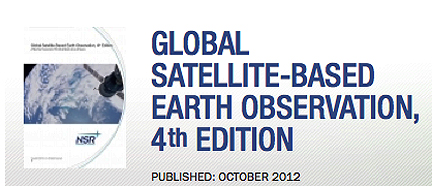The battle will mainly take place on cost and spatial resolution and to win it, EO satellite operators must confront shutter-control regulations ASAP, as well as having a solid understanding and response to oncoming UAV competition. In NSR’s Global Satellite-Based Earth Observation, 4th Edition report, it was indicated that UAV EO capabilities have been ramping-up, but only recently was it reported to NSR that several aerial imaging companies are embracing UAVs. Not surprising, UAVs and airplanes feature similar characteristics, and it illustrates that current UAV capabilities are up to market standards. This is confirmed by a series of announcements such as NASA’s use of a Predator-B for science missions or Trimbles’ acquisition of Gatewing, a provider of lightweight UAVs.
 Essentially the source of EO data (be it from UAVs, satellites or airplanes) does not matter to the end user beyond its influence on characteristics of the data. Plus, switching between data sources is neither complicated nor costly; therefore, the impact is that final users are increasingly source-agnostic. As a result, the EO data market is open to every source able to deliver data with the right feature-price mix, thus intensifying the competition between satellites and UAVs.
Essentially the source of EO data (be it from UAVs, satellites or airplanes) does not matter to the end user beyond its influence on characteristics of the data. Plus, switching between data sources is neither complicated nor costly; therefore, the impact is that final users are increasingly source-agnostic. As a result, the EO data market is open to every source able to deliver data with the right feature-price mix, thus intensifying the competition between satellites and UAVs.
One aspect of the competition, traditionally one of satellites’ weak-points, could be the time from order to delivery. However, recent EO satellite operator expansion of their receiving ground station networks and of their direct receiving stations has largely softened this issue.
Another factor could be the flexibility of tasking a specific area. On one hand, satellite orbits are largely fixed and their coverage areas rigid, while UAV mission plans are designed “on-demand”, to cover specific areas. On the other hand, satellites compensate their rigidity with extremely large coverage areas thanks to their altitude, while UAVs have to fly rather close to their targets, requiring mission plans made of contiguous/close targets.
Both solutions are hampered by regulations; satellites by shutter-control regulations, while UAVs have to obtain authorization to access civil skies. The latter are progressively granted, but satellite shutter-control regulations are not showing any signs of softening. In the end, the competition should focus on spatial resolution and cost. UAVs are characterized by low CAPEX but high OPEX, which leads to order-based operations. Satellites, for their part, still require considerable investments but once in-orbit feature a low OPEX, allowing operators to optimize their imaging capabilities and build huge archives.
Both sources are direct competitors in the sub-meter imagery segment and given its size (70 percent of the space-based EO data market in 2011), the outcome of the battle will largely shape the future of space-based EO.
Satellites now compete against a technology located closer to the ground, mechanically allowing for a much better resolution. Moreover, UAVs and satellites’ technologies are evolving at different rates. Finally, if shutter-control regulations are kept unchanged, UAVs will thrive in a comfortable protected market. The resulting profits could be used to compete with satellites in the rest of the sub-meter segment. If today’s fight between UAVs and satellites is mainly at the 0.3 to 0.5m range, those profits could contribute to move the battle to a lower resolution (above 0.5 m).
NSR believes the sub-half-meter EO imagery segment may constitute the biggest market in a decade, mainly thanks to new applications. Consequently, as switching costs are low and besides improving the value-proposition, another classical solution is to control the substitute, to acquire competitors. Some satellite operators tried it without success in recent years, but it was probably too early. However, given UAV capabilities and evolution as of late, they may want to have another look at those, currently small, companies instead of waiting for the battle to move to the next round.—Report by Stéphane Gournair, Analyst, NSR France

